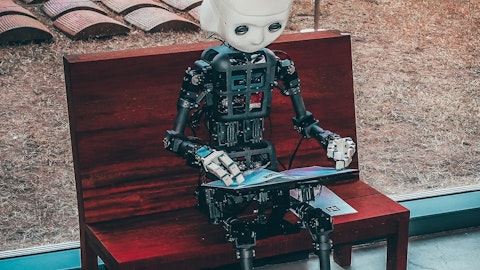We are able to provide speed for customers that require speed and not all of them do. We can go from LA to Texas, a close to 2,000 mile journey and we do that in 48 hours. So that’s truck like. So – and our service that we put on from Mexico going into Eastern Canada, partnering with CN and ourselves into the East plus into Chicago is unparalleled. We can do it as fast as anybody. So there’s lots of opportunity out there for us. And what we have to do is with good service, the customers will see what’s possible, and they will want to partner with Union Pacific and grow their business with us versus anybody else. Kenny?
Kenny Rocker: Yes. So first of all, we have a robust business development pipeline. It’s a healthy one. It’s an encouraging one. We’re excited about the pipeline in front of us, so a lot of opportunities there. The main thing I want to start with is our service product is in a strong position. And so as we talk about the service that we sold to customers, you look at some of the markets, just to get a little bit more detail here. Look at coming out of Mexico, that’s a service product that Eric has given us daily. That’s undisputed and unmatched coming out of Mexico. It’s the fastest product. It’s also a product that is on time. You look at the West Coast and someone asked me a question earlier, we’re blessed with a network where we can pitch and we can catch.
We can pitch coming out of the West Coast as we onboard and on dock. We’ve got a strong IPI. We can catch in the Inland Empire. We built that up. We put investments there, and we’ve shared with you that we’ve got plans to really grow in that area. And with the network and the service product we have, we’re expecting to grow. If you look at the carload side, you’ve heard us talk about some of the wins in the auto side. I talked about the petrochem side. That’s a great network down in the Gulf Service Park [ph] is improving. Our commercial leaders, commercial teams are sitting out there and talking to customers about taking a little bit more truck off the road. So we’re bullish on getting out there and growing as the service product is there, and we’re investing in the network.
Allison Poliniak: Great. Thank you.
Operator: Our next question is from the line of Brandon Oglenski with Barclays. Please proceed with your question.
Brandon Oglenski: Hey, good morning. And thanks for taking my question. Eric, I wanted to come back to you because I think in response to an earlier question, you spoke about, there’s still more to come on things like velocity and train length. And then I think Jim even alluded to some local service plan changes. So do you want to elaborate a little bit more on where you see productivity gains this year?
Eric Gehringer: Absolutely. So you mentioned car velocity, so let’s start there. As you’re thinking about 2024 and what’s in front of us, you saw what we did in the fourth quarter, a 14% improvement, 217 miles per day. That becomes a floor. A floor that is we work every single day, as was mentioned before, we’re working to improve that. Now if you peel that back and you say, okay, within that, where do you see the biggest opportunities? You mentioned train length, so we can start there. Train length is an opportunity, always has been and candidly always will be because the railroad is dynamic. Train length comes in two forms. The first one, Kenny just gave a great example of Inland Empire, where we’re bringing more volume onto the railroad.
I already have an existing train, and we can just tack it onto the back of that. The other way that it comes is in our actual transportation plan changes that we make. An example of that is the one that Kenny brought up with Mexico. When you think about that being two trains before and now we’re consolidating that traffic into one, it allows us to drive productivity that way. After that, the fluidity drives our locomotive fleet. There’s other factors, but at the very core of it, it is about fluidity. We took out 500 units out of the system in the second half of last year, a little bit because of volume, but the vast, vast majority of it because of fluidity, continuing that work allows us to continue to rightsize the fleet. And we don’t talk a lot about purchase services on these calls, but purchase service is a big opportunity for us, whether you’re thinking about how many vehicles do we have on this railroad to operate it, whether we think about how much fuel that we’re using.
We also have opportunities on the casualty side. As Jennifer has mentioned many times before, it’s an opportunity all the way from the safety side. That’s why we’re so focused on safety as well as even as we think about our service product, right? We have teams that are dedicated to making sure that the freight that we haul is successfully hauled from origin to destination without being damaged and how do we drive down any claims that we have. So it is a target-rich environment, and we are doing everything every day to capitalize on that.
Brandon Oglenski: Thank you.
Operator: Our next question is from the line of Bascome Majors with Susquehanna. Please proceed with your question.
Bascome Majors: Following up on the locomotive piece earlier, you talked about storing 500 units and having a 9% sequential increase in productivity. Jim, as you look forward a bit further, can you talk about how you think about UP’s fleet renewal strategy for locomotives over the next, call it, 3 to 5 years? And how at this point is some of the regulations that California is proposing impacting the way that you think strategically about that significant investment for the railroad? Thank you.
Jim Vena: Bascome, I think it’s a great question. If you looked at the bottom line, we have enough locomotives that we would not have to look in the planning period of 3 years out that we would have to purchase any locomotives. But we always look at the greenhouse gas emissions of our locomotives, what we need to do to be able to invest to make them more efficient, both on a fuel spend and greenhouse gas emissions. So I think we will target certain capital expenditures. It’s not in the plan this year, and we’ll look at it again to see where we are. We’re testing new innovative ways to have propulsion. So we’ll continue to do that and invest in locomotives that can be hybrid that are able to work out there for us. So and in certain situations, we can implement it.
But I don’t see the requirement is that we do not have to spend money. But bottom line is we know that we will invest in our fleet. And we don’t want to have the oldest fleet in the network. So we’ll continue to invest in renewing the fleet as we move ahead, but it will not happen in 2024.
Bascome Majors: Thank you.
Jim Vena: You’re welcome, Bascome,
Operator: The next question is from the line of Ken Hoexter with Bank of America. Please proceed with your question.
Ken Hoexter: Hey, good morning and congrats on solid and rapid results here. Just want to check, I guess you’re not changing that you don’t need volume gains to get margin improvement. Is that right? Am I hearing that right? And then your thoughts on outpacing normal sequential shifts into the first quarter, should we still expect that like you did in the fourth quarter, given the weather or accelerating gains? And then just a side one, Kenny, I just want to understand, are you – can you talk about the scale of the intermodal loss in ’24? Did we see it in the fourth quarter? Or is that all coming? And can you talk scale? I guess that was a surprise, I think, to everybody so far.
Jim Vena: Okay. So three questions, Ken. That was very good. I like – so why don’t we start…
Jennifer Hamann: Where are we going to start?





